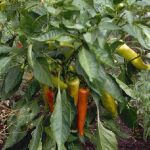| Common Name: |
Capsicum chinense |
| Botanical Name: |
Capsicum chinense syn. C. sinense |
| Genus: |
Capsicum |
| Family: |
Solanaceae |
| Location: |
West Indies, southern C America, northern S America |
| Cultivation: |
Rich, well-drained soil in sun. Capsicum baccatum var. pendulum and C. pubescens withstand cooler conditions. Capsicum pubescens may be espaliered or pruned. Plant bugs may damage growing points and leaves; plants under cover may be affected by spider mite, whitefly, and aphid. |
| Propagation: |
By seed sown in early spring. |
| Harvest: |
Unripe fruits are picked as required and used raw, pickled, or cooked. Ripe fruits are picked in summer and used fresh, pickled, or dried for condiments, decoctions, ointments, powders, tinctures, tablets and oleo-resin. |
| Height: |
1.5m (5ft) |
| Width: |
1.5 (5ft) |
| Variations: |
Habeñero
Is a pod type from Belize and the Yucatan Penisula of Mexico, with orange-red, lantern-shaped fruits, 6cm (2½in) long and 2.5cm (1in) wide. The hottest chili, is used fresh in salsas, in cooked dishes, and fermented for hot sauces.
Height: 1-1.2m (3-4ft)
Width: 60cm (24in) |
Scotch Bonnet
Is a large-leafed cultivar with fiercely hot, crumpled, beret-shaped fruits that mature red, orange, yellow, or white.
Height: 1.1m (3¼ft)
|
Rocotillo
From Puerto Rica, is similar to 'Scotch Bonnet' but long-stalked and slightly milder. Used in "jerk" seasoning.
|
| Hardiness: |
Min. 4-21°C (39-70°F) depending on cultivar. |
| Parts Used: |
Fruits |
| Properties: |
As for pungent-fruited cultivars of C. annuum. |
| Medicinal Uses: |
As for pungent-fruited cultivars of C. annuum. |
| Culinary Uses: |
As for pungent-fruited cultivars of C. annuum. |
| Warning: |
Capsicum oleo-resin is subject to legal restrictions in some countries. |
| Bibliography: |
Encylopedia of Herbs by Deni Brown Copyright ©: 1995, 2001 Dorling Kindersley Limited pp 153-154, 155
|
|

